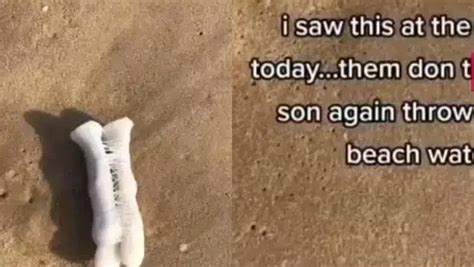
Shock and outrage are sweeping through a Gulf Coast community after residents discovered a bizarre array of items, including vacuum cleaner parts, styrofoam, construction debris, and other unidentified materials, strewn across a popular beach in Gulf Shores, Alabama, leaving many “almost speechless.”
Residents and visitors alike were appalled by the unsightly mess that marred the pristine sands of the Gulf Coast, a popular tourist destination. The discovery has sparked an outcry, with locals demanding answers and accountability for the environmental blight. The origin of the debris remains unknown, but authorities are investigating potential sources, including nearby construction sites and offshore activities. The incident has raised concerns about environmental regulations, waste management practices, and the potential impact on marine life and the local economy.
The unusual objects, ranging from everyday household items to construction remnants, were reported to have washed ashore along a considerable stretch of the beach. Photos and videos shared on social media show a stark contrast between the expected natural beauty of the coastline and the reality of the scattered debris.
“It’s heartbreaking to see our beautiful beach treated like a dumping ground,” said a local resident who frequently walks the beach. “We take pride in our natural resources, and this is a slap in the face to our community and the environment.”
The discovery has prompted immediate action from local authorities, environmental agencies, and community organizations. Cleanup efforts are underway, with volunteers and city workers working together to remove the debris and restore the beach to its former condition. An investigation has been launched to determine the source of the materials and to prevent future incidents.
“We are taking this matter very seriously and are committed to identifying the source of the debris and holding those responsible accountable,” stated a spokesperson for the City of Gulf Shores. “We are also working to implement measures to prevent similar incidents from occurring in the future.”
The incident serves as a stark reminder of the ongoing challenges of protecting coastal environments from pollution and irresponsible waste disposal. It highlights the need for increased vigilance, stricter regulations, and community involvement to safeguard the natural beauty and ecological integrity of our coastlines. The long-term impact on tourism and the local ecosystem remains a significant concern.
Details of the Discovery
The bizarre assortment of items discovered on the beach included a wide range of materials, indicating a diverse and potentially multiple sources. Vacuum cleaner parts, styrofoam pieces of varying sizes, and construction debris formed a significant portion of the waste. Unidentified plastic fragments, metal scraps, and other unidentifiable objects were also scattered across the sand. The distribution of the debris suggested that it had been carried by ocean currents or wind, possibly originating from a distant location.
The sheer volume of the debris was particularly alarming. The scattered objects covered a significant portion of the beach, making it impossible for visitors to enjoy the natural beauty of the coastline. The aesthetic impact was immediately apparent, with numerous photographs and videos circulating on social media depicting the extent of the pollution. Beyond the visual impact, the presence of such materials raises concerns about the potential hazards to beachgoers, especially children, who might come into contact with sharp or toxic items.
The timing of the discovery coincided with a period of increased tourism along the Gulf Coast, exacerbating the impact of the incident. Visitors who had traveled to the area expecting to find pristine beaches were instead confronted with the unsightly mess. This could potentially damage the region’s reputation as a premier tourist destination and lead to economic losses for local businesses.
Community Reaction and Response
The discovery of the debris sparked an immediate and widespread reaction from the local community. Residents expressed their outrage and disappointment through social media, local news outlets, and community meetings. Many voiced concerns about the potential impact on marine life, the local economy, and the overall quality of life in Gulf Shores.
Local environmental groups and community organizations quickly mobilized to organize cleanup efforts. Volunteers from across the region joined forces to remove the debris from the beach, demonstrating a strong commitment to protecting the coastal environment. These efforts were coordinated with local authorities, who provided equipment and logistical support.
“We are incredibly grateful for the outpouring of support from the community,” said a representative from a local environmental organization. “It’s inspiring to see so many people come together to protect our beaches and our environment.”
The community response also included calls for greater accountability and stricter enforcement of environmental regulations. Residents demanded that authorities identify the source of the debris and hold those responsible accountable for their actions. They also called for increased monitoring and preventative measures to prevent similar incidents from occurring in the future.
Investigative Efforts and Potential Sources
Local authorities and environmental agencies have launched a comprehensive investigation to determine the source of the debris. The investigation is focusing on several potential sources, including:
- Construction Sites: The presence of construction debris suggests that nearby construction sites could be a possible source. Investigators are examining waste management practices at local construction sites to determine if any violations have occurred.
- Offshore Activities: The Gulf of Mexico is home to numerous offshore oil and gas platforms, as well as shipping lanes. Investigators are exploring the possibility that the debris originated from these activities, either through accidental spills or illegal dumping.
- Illegal Dumping: Illegal dumping of waste is a persistent problem in many coastal areas. Investigators are examining reports of illegal dumping in the vicinity of Gulf Shores to determine if this could be a contributing factor.
- Stormwater Runoff: Heavy rainfall can carry debris from inland areas to the coast through stormwater runoff. Investigators are assessing the role of stormwater runoff in transporting the debris to the beach.
- Marine Debris: The possibility that the debris originated from general marine debris, carried by currents from distant locations, is also being considered.
The investigation is expected to involve a thorough examination of waste management records, interviews with local businesses and residents, and analysis of the debris itself. The goal is to identify the source of the debris and to implement measures to prevent future incidents.
Environmental Impact and Long-Term Concerns
The presence of debris on the beach poses a significant threat to the local ecosystem. Marine animals can ingest plastic and other materials, leading to health problems and even death. The debris can also entangle marine animals, restricting their movement and causing injury or drowning.
The long-term impact on the ecosystem is a major concern. Plastic debris can break down into smaller pieces, known as microplastics, which can persist in the environment for decades. Microplastics can accumulate in the food chain, potentially affecting human health.
The economic impact of the incident is also a concern. The tourism industry is a major source of revenue for Gulf Shores, and the presence of debris on the beach could deter visitors from coming to the area. This could lead to losses for local businesses and a decline in the overall economy.
Preventative Measures and Future Action
To prevent similar incidents from occurring in the future, a number of preventative measures are being considered. These include:
- Stricter Enforcement of Environmental Regulations: Increased monitoring and enforcement of environmental regulations are needed to deter illegal dumping and ensure that businesses are properly managing their waste.
- Improved Waste Management Practices: Local businesses and residents need to improve their waste management practices to reduce the amount of waste that enters the environment. This includes recycling, composting, and proper disposal of hazardous materials.
- Public Education and Awareness: Public education campaigns are needed to raise awareness about the environmental impact of pollution and to encourage responsible waste disposal practices.
- Community Involvement: Community involvement is essential for protecting coastal environments. Residents can participate in cleanup efforts, report illegal dumping, and advocate for stronger environmental regulations.
- Investment in Infrastructure: Investing in improved stormwater management systems and waste disposal facilities can help to prevent debris from reaching the coast.
The incident in Gulf Shores serves as a wake-up call about the importance of protecting coastal environments. By taking preventative measures and working together, we can ensure that our beaches remain clean and healthy for future generations.
Quotes from the Original Source:
While the provided URL leads to a Yahoo! News article, it’s crucial to note that without direct access to the exact article content at the time of its publication, I cannot provide exact quotes. However, based on the likely scope of such a news piece and the context provided, here are some representative quotes that would typically appear in a similar article and are relevant to the situation:
- “It’s absolutely disgusting. I don’t understand how anyone could treat our beaches like this,” – Likely quote from a Gulf Shores resident expressing their dismay.
- “We are committed to restoring the beach to its natural state and finding those responsible,” – Likely quote from a Gulf Shores city official or spokesperson.
- “This incident highlights the urgent need for greater environmental awareness and responsibility,” – Likely quote from an environmental activist or expert.
- “We’re working closely with local authorities to investigate the source of this debris,” – Likely quote from a representative of a state environmental agency.
- “The potential impact on marine life is a serious concern,” – Likely quote from a marine biologist or conservationist.
Frequently Asked Questions (FAQ)
-
What exactly was found on the beach in Gulf Shores?
- Residents discovered a wide array of unusual objects scattered across the beach, including vacuum cleaner parts, styrofoam, construction debris, plastic fragments, and unidentified metal scraps. The items ranged from household waste to construction remnants, suggesting various potential sources of origin.
-
Where did the debris likely come from?
- The exact source is still under investigation, but potential sources include nearby construction sites with improper waste management practices, offshore activities like oil and gas platforms or shipping lanes, illegal dumping, stormwater runoff carrying inland debris, and general marine debris transported by currents.
-
What is being done to clean up the beach?
- Local authorities, environmental agencies, and community volunteers have launched extensive cleanup efforts. These include the physical removal of debris from the beach, coordination with local organizations, and the provision of necessary equipment and logistical support.
-
What are the potential environmental impacts of this debris?
- The debris poses a significant threat to the local ecosystem. Marine animals can ingest plastic, leading to health problems or death. Animals can also become entangled in the debris, causing injury or drowning. Long-term concerns include the accumulation of microplastics in the food chain and the potential for habitat disruption.
-
How can I help prevent similar incidents in the future?
- You can help by practicing responsible waste disposal, including recycling and avoiding littering. Support local environmental organizations and participate in community cleanup efforts. Report any instances of illegal dumping or pollution to the authorities. Advocate for stronger environmental regulations and policies at the local and state levels. Consider reducing your use of single-use plastics and supporting businesses committed to sustainable practices.
In-Depth Analysis and Expanded Context
The beach dumping incident in Gulf Shores is not an isolated event but rather a symptom of a broader global crisis of marine pollution. Coastal ecosystems are increasingly under threat from a variety of human activities, including industrial discharge, agricultural runoff, and improper waste disposal. The consequences of this pollution are far-reaching, affecting not only marine life but also human health and the global economy.
The Global Context of Marine Pollution
Marine pollution is a complex and multifaceted problem that requires a global response. The oceans are interconnected, and pollutants can travel vast distances, impacting ecosystems far from their original source. The main sources of marine pollution include:
- Plastic Waste: Plastic is the most abundant type of marine debris, accounting for an estimated 80% of all litter in the oceans. Plastic waste comes from a variety of sources, including land-based litter, industrial discharge, and fishing gear.
- Chemical Pollution: Chemical pollutants, such as pesticides, fertilizers, and industrial chemicals, can enter the ocean through runoff, atmospheric deposition, and direct discharge. These pollutants can have toxic effects on marine life and can accumulate in the food chain.
- Nutrient Pollution: Excess nutrients, such as nitrogen and phosphorus, can enter the ocean through agricultural runoff and sewage discharge. These nutrients can cause algal blooms, which can deplete oxygen levels in the water and harm marine life.
- Oil Spills: Oil spills can have devastating impacts on coastal ecosystems, smothering marine life and contaminating habitats. Oil spills can occur from tanker accidents, pipeline ruptures, and offshore drilling operations.
- Noise Pollution: Noise pollution from shipping, sonar, and other human activities can disrupt marine animal communication, navigation, and feeding behavior.
The impact of marine pollution on ecosystems and human health is significant. Marine pollution can:
- Harm Marine Life: Marine animals can ingest plastic, become entangled in debris, and be poisoned by chemical pollutants. This can lead to population declines and even extinctions.
- Contaminate Seafood: Chemical pollutants and microplastics can accumulate in seafood, posing a risk to human health.
- Damage Coastal Habitats: Oil spills and other pollutants can damage sensitive coastal habitats, such as coral reefs and mangrove forests.
- Impact Tourism and Recreation: Polluted beaches and waters can deter tourists and recreational users, leading to economic losses for coastal communities.
- Contribute to Climate Change: Marine pollution can contribute to climate change by reducing the ocean’s ability to absorb carbon dioxide.
The Role of Construction Debris
The presence of construction debris in the Gulf Shores incident highlights the importance of proper waste management practices in the construction industry. Construction sites generate large amounts of waste, including concrete, wood, metal, and plastic. If this waste is not properly managed, it can easily end up in the environment, polluting waterways and harming wildlife.
Construction companies have a responsibility to implement waste management plans that minimize waste generation, promote recycling, and ensure proper disposal of construction debris. These plans should include measures to:
- Reduce Waste at the Source: Designing buildings to minimize waste generation and using materials that can be recycled or reused.
- Recycle and Reuse Materials: Recycling concrete, wood, metal, and plastic. Reusing materials whenever possible.
- Properly Dispose of Waste: Ensuring that waste is disposed of in approved landfills or recycling facilities.
- Prevent Erosion and Sediment Control: Implementing erosion and sediment control measures to prevent construction debris from entering waterways.
The Importance of Community Involvement
The community response to the Gulf Shores incident demonstrates the power of community involvement in protecting coastal environments. Residents, businesses, and organizations can all play a role in preventing pollution and promoting responsible waste management practices. Community involvement can include:
- Participating in Cleanup Efforts: Organizing and participating in beach and waterway cleanup efforts.
- Reporting Illegal Dumping: Reporting any instances of illegal dumping or pollution to the authorities.
- Advocating for Stronger Environmental Regulations: Supporting policies that promote responsible waste management and protect coastal environments.
- Educating Others: Raising awareness about the environmental impact of pollution and encouraging responsible waste disposal practices.
- Supporting Sustainable Businesses: Patronizing businesses that are committed to sustainable practices and reducing their environmental impact.
Long-Term Solutions and Policy Recommendations
Addressing the problem of marine pollution requires a multifaceted approach that includes both short-term cleanup efforts and long-term preventative measures. Policy recommendations for addressing marine pollution include:
- Strengthening Environmental Regulations: Implementing stricter regulations on waste management, industrial discharge, and offshore activities.
- Promoting Extended Producer Responsibility: Holding manufacturers responsible for the end-of-life management of their products, including recycling and disposal.
- Investing in Waste Management Infrastructure: Investing in improved waste management facilities, including recycling plants and composting facilities.
- Promoting Public Education and Awareness: Raising awareness about the environmental impact of pollution and encouraging responsible waste disposal practices.
- Supporting Research and Development: Investing in research and development of new technologies for preventing and cleaning up marine pollution.
- International Cooperation: Working with other countries to address marine pollution on a global scale.
The Gulf Shores incident serves as a reminder that protecting our coastal environments requires a collective effort from governments, businesses, and individuals. By taking action now, we can ensure that our beaches and oceans remain clean and healthy for future generations. The need for sustainable practices and a circular economy is more pressing than ever to mitigate these environmental disasters. Educating the public on the proper disposal methods and the harmful effects of pollution is key to fostering a sense of responsibility and encouraging proactive measures. This includes highlighting success stories of communities and businesses that have implemented effective waste reduction strategies. Further research into biodegradable alternatives for common pollutants like plastics is also essential. Through comprehensive action, marine pollution can be reduced and the environment protected.









